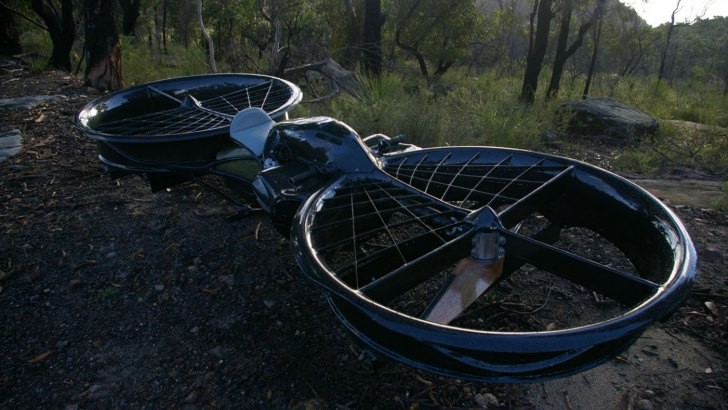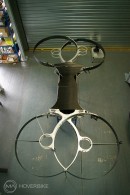It looks like a flying motorcycle is the next step in personal transport, as the Hoverbike project steps into a new development phase. It will not be exactly like the Speeder Bike in Star Wars, but it will definitely pack massive amounts of fun. Mallow Aeronautics’ new-design quad-copter drone is already founded via Kickstarter and it represents the base upon which the final version of the Hoverbike will be built.
The first flying motorcycle Malloy developed was a bi-copter design, and it was successfully tested in both unmanned and manned trials. However, it looks like the dual-rotor design is not enough to provide the level of maneuverability and safety needed before applying for a commercial flying license. So the new Hoverbike the company envisages will replicate the quad-copter design with overlapping rotors.
So far, the Hoverbike technology is only available as a 1/3 scale model drone. The gadget is fully functional and available commercially, but it also serves as a comprehensive testing platform for the full-scale bike. Malloy Aeronautics has estimated that reaching a final prototype stage for the Hoverbike needs a funding of $1.1 million (€973,000 at today’s exchange rate) so the donation campaign was prolonged until the goal is reached. You can make direct donations, buy t-shirts and other goods at hover-bike.com.
It will be complemented by a 30-liter (7.9 US gal) primary fuel tank which can be expanded to 60 liters (15.8 S gal) with secondary tanks. The Hoverbike has a dry weight of 105 kg (232 lb), thanks to the extensive use of carbon fiber and has a maximum takeoff weight over 270 kg (596 lb).
Riding/flying the Hoverbike at a cruise speed of 80 knots (148 km/h) provides a range of 148 km (92 miles) with the primary tank and 290 km (180 mniles) with the auxiliary ones. The fuel economy is definitely not as glorious as the one of the BMW R1200GS, but you can fly in a straight line and this might just do.
So far no commercial future is envisaged for the Hoverbike, but Chris Malloy says he will offer the first prototype to one of the donors. However, when the prototype will be ready, a guideline for mass production would have been already laid out, taking the Hoverbike as close as it gets to becoming a consumer product.
The simplicity of a motorbike and the freedom of a helicopter
At the heart of the design is Chris Malloy’s desire to come up with a new transport method which combines the simplicity of riding and operating a motorcycle and the freedom flying a helicopter provides. After he got his helicopter license he acknowledged that helicopters need many improvements, so the main idea behind the Hoverbike started to look more and more like a plan.So far, the Hoverbike technology is only available as a 1/3 scale model drone. The gadget is fully functional and available commercially, but it also serves as a comprehensive testing platform for the full-scale bike. Malloy Aeronautics has estimated that reaching a final prototype stage for the Hoverbike needs a funding of $1.1 million (€973,000 at today’s exchange rate) so the donation campaign was prolonged until the goal is reached. You can make direct donations, buy t-shirts and other goods at hover-bike.com.
A BMW boxer engine to fly the Hoverbike
In case the engine shown in these pictures seems strangely familiar, you should know it is indeed a BMW boxer, packing 1170cc displacement and capable of producing 80 kW (107 hp) at 7,500 rpm. It was chosen because of the shape which suited the overall design perfectly and because of its air cooling system which saves a lot of weight.It will be complemented by a 30-liter (7.9 US gal) primary fuel tank which can be expanded to 60 liters (15.8 S gal) with secondary tanks. The Hoverbike has a dry weight of 105 kg (232 lb), thanks to the extensive use of carbon fiber and has a maximum takeoff weight over 270 kg (596 lb).
Riding/flying the Hoverbike at a cruise speed of 80 knots (148 km/h) provides a range of 148 km (92 miles) with the primary tank and 290 km (180 mniles) with the auxiliary ones. The fuel economy is definitely not as glorious as the one of the BMW R1200GS, but you can fly in a straight line and this might just do.
So far no commercial future is envisaged for the Hoverbike, but Chris Malloy says he will offer the first prototype to one of the donors. However, when the prototype will be ready, a guideline for mass production would have been already laid out, taking the Hoverbike as close as it gets to becoming a consumer product.








